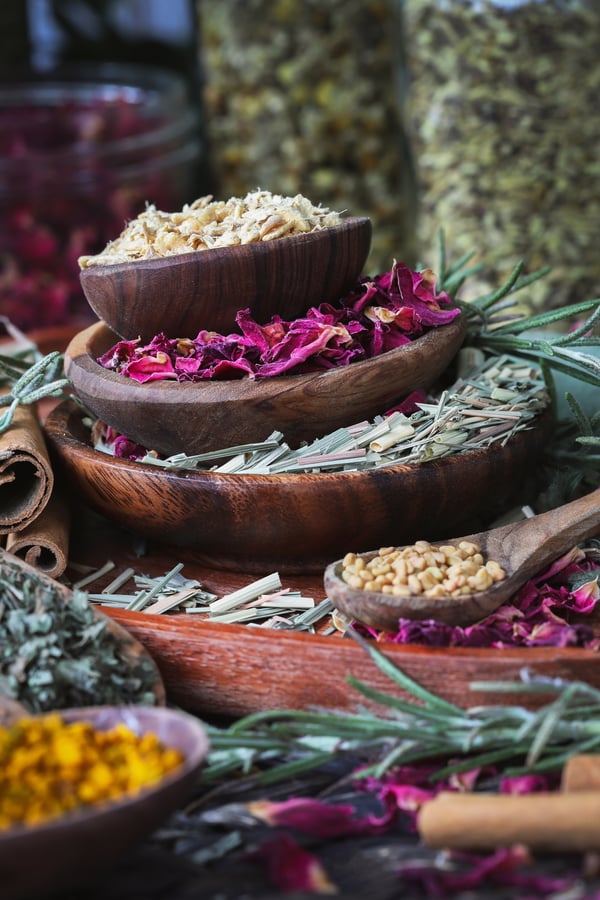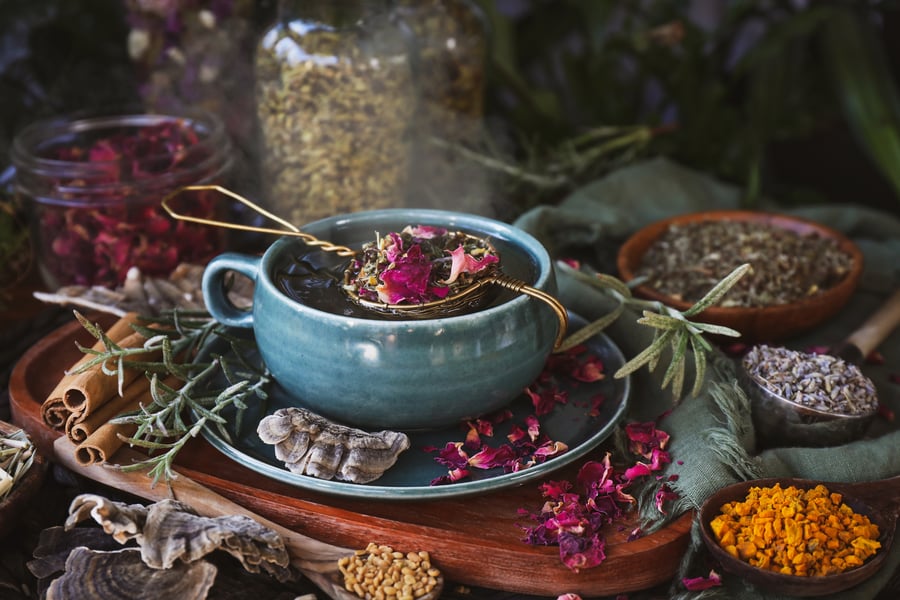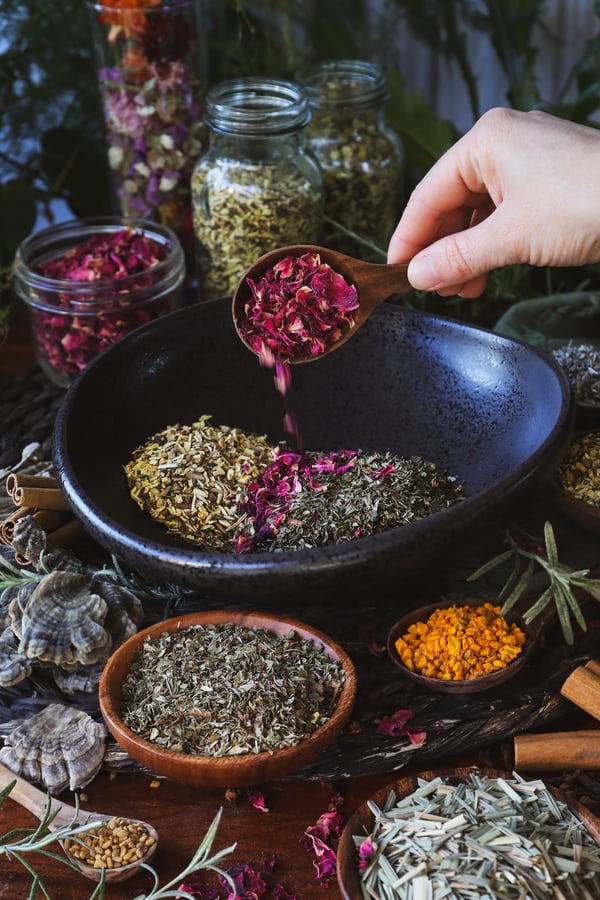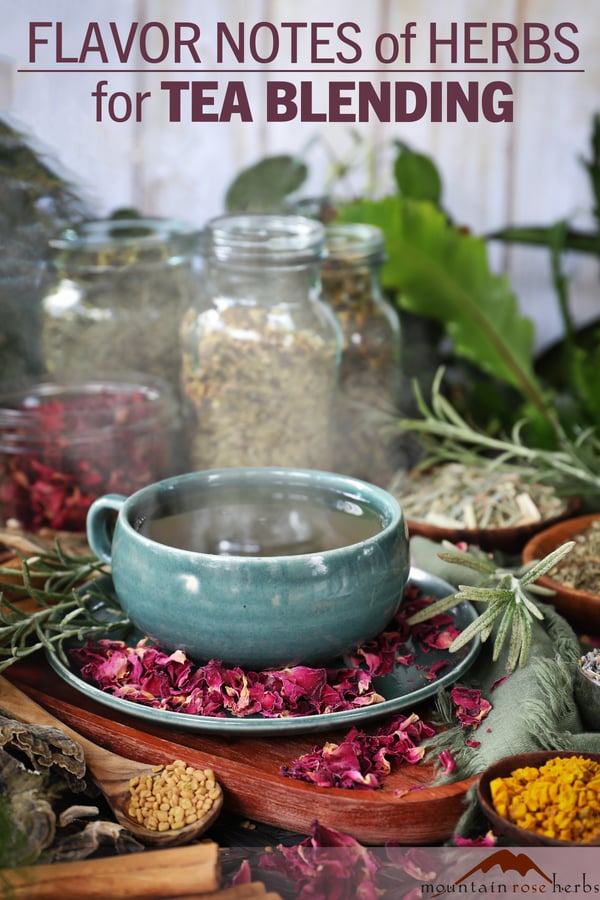As herbalists, many of us create infusions (teas) with health and wellness in mind, choosing herbs based on what constituents they can provide us. As tea enthusiasts, we also care about the tea-drinking experience and the synergistic way that the flavors and aromas of different herbs can join together when put in hot water. It is this synergy that comes into play with tasting notes. Tasting notes are the descriptive language that connoisseurs use to help us understand the nuances at play in each cup: a set of terms to describe visual cues, aromas, taste, sensations, and more. I can’t tell you why ‘tangy, lively, and refreshing’ are the flavor notes in my everyday go-to drink-it-all-day herbal tea, but knowing those terms helps steer me toward other herbs and spices that work well together when making my own herbal tea blends.
Fun factoid: Caffeine-free herbal infusions are technically called tisanes. True tea is made from the leaves of the Camellia sinensis plant. Herbal tea is a modern colloquialism that more or less means botanical material steeped in water.
The Language of Herbal Tea
Although there is specific tasting note terminology for Camellia sinensis teas, herbal teas are wildly diverse in appearance, flavor, aroma, and more. And, because we use many of the same herbs and spices for culinary recipes and herbal formulating, the tasting notes we use often are the same ones used for food. The human tongue, on its own, can distinguish five tastes: bitter, salty, sour, sweet, and umami. However, because of the working relationship between the tongue, nose, throat, and brain, we can actually identify thousands of aromas and flavors that our tongue alone cannot.
Tasting Notes for Herbs and Spices in Herbal Teas
- Bitter—Sometimes called pungent, sharp, or acrid. A bitter element can balance sweet and salty and enhance umami. Bay leaves, celery seed, fenugreek seed, lavender flower, licorice root, mace, marjoram leaf, mustard seed, oregano leaf, thyme leaf, turmeric root
- Salty—In Ayurveda, “salty” includes botanicals with a high mineral content. Use in moderation to not overwhelm an herbal tea blend. Black cohosh, cleavers, echinacea root, elecampane root, nettle leaf, plantain leaf
- Sour—Acidic tartness. Use judiciously to balance sweet, bitter, and umami. Hibiscus flower, lemon peel, lemon balm, lemon verbena, lime peel, sorrel, sumac berry, tamarind
- Sweet—Not bitter or astringent. May range from mild natural sweetness to honey-like. Help to balance bitter and sour. Anise seed, cardamom, cinnamon, chervil, cloves, coconut flakes, dill weed, fennel seed, hemp seeds, licorice root, meadowsweet leaf, mints, nutmeg, oat tops, poppy seeds, sesame seeds, star anise, stevia leaf
- Umami—Savory and deeply flavored. Enhanced by bitter. Basil leaf, caraway seed, fenugreek seed, garlic, mushrooms, mustard seed, nettle leaf
- Earthy—Rich and minerally, straight from the earth. Annato (achiote), cumin seed, oat tops, turmeric root
- Floral—Strong aromatic qualities that heavily influence flavor. Sweet, tart, bitter, or peppery. Easy to use too much, so add judiciously. Basil leaf, coriander seed, lavender flower, lemongrass, rose petals, saffron, thyme leaf
- Fruity—Bright, fruity aroma and bracing flavor that may be berry-like, sweet and juicy, or tart and citrusy. Anise seed, coriander seed, fennel seed, nigella, summer savory, star anise, tamarind
- Herbaceous—Full of individual personality. Flavor-forward with a lingering aroma. May be clean, cooling, grassy, warm, or peppery. Dill weed, fennel seed, lavender flower, oregano leaf, parsley leaf, rosemary leaf, sage leaf, summer savory, tarragon, thyme leaf
- Nutty—Rich, a little buttery, with savory woodsy notes. Black cardamom, caraway seeds, coriander seed, cumin seed, fenugreek seed, mustard seed, poppy seed, sesame seed
- Piney—Aromatic, biting, with balsamic notes. Bay leaf, black peppercorns, rosemary leaf, thyme leaf
- Pungent—Boldly flavored with strong aromatics. May be hot, acrid, sharp, or biting. Allspice, dill seed, epazote, garlic, ginger root, grains of paradise, licorice root, marjoram, mustard seed, paprika, spearmint leaf, star anise
- Spicy—Bold, sharp, and appetizing. Often hot and zingy, but with a gentle finish on the tongue. Add to blend carefully so as not to overdo the spice. Bay leaf, cinnamon, cloves, coriander seed, cumin seed, ginger root, marjoram leaf, nutmeg
- Woody—Fragrant and woodsy, evoking deep forest. Often robust, appetizing, and warm. Cardamom, cinnamon, cloves, juniper berry, lavender flower, rosemary leaf, Szechuan peppercorns

Tasting a tea ingredient before purchasing is ideal, but if you’re buying a pre-blended herbal tea or tea herbs online, knowing what you like and being able to decipher the tasting notes will help you more successfully try new blends that you’re going to love. For instance, if you had an herbal tea once that was described as floral, and you either loved it or disliked it, you don’t need to exactly understand what the tea taster meant by the term floral; the word alone helps you know that you want to replicate that note in a tea blend or you want to avoid it at all costs. By exploring other floral herbs and spices, you may find a wealth of new herbs to add to your repertoire.
Ready to Make Your Own Tea Blends?
Explore How to Create Your Own Herbal Tea Blends
You May Also Enjoy:













